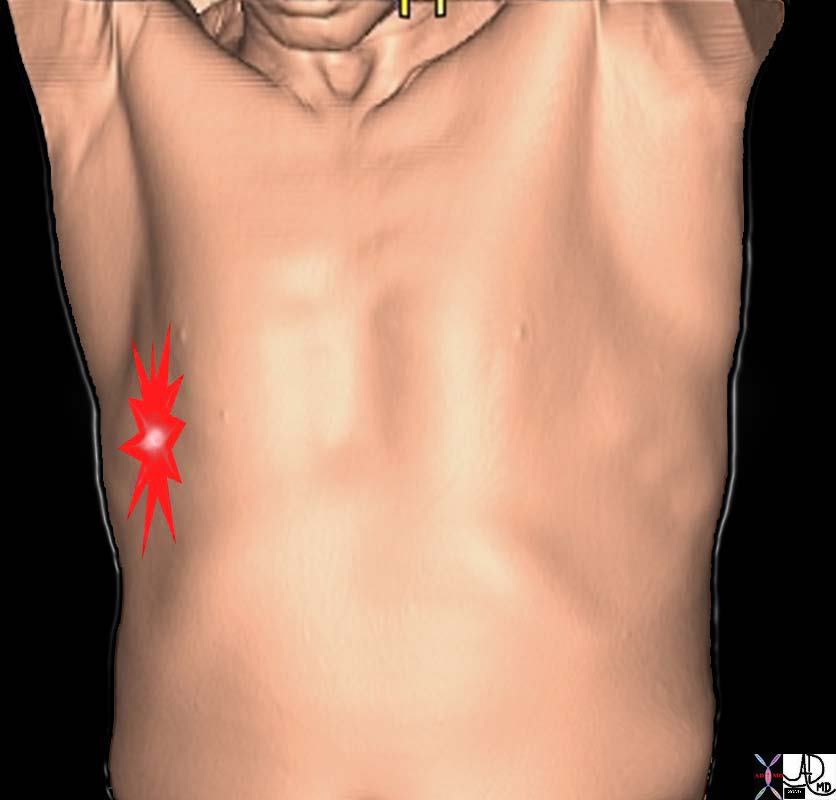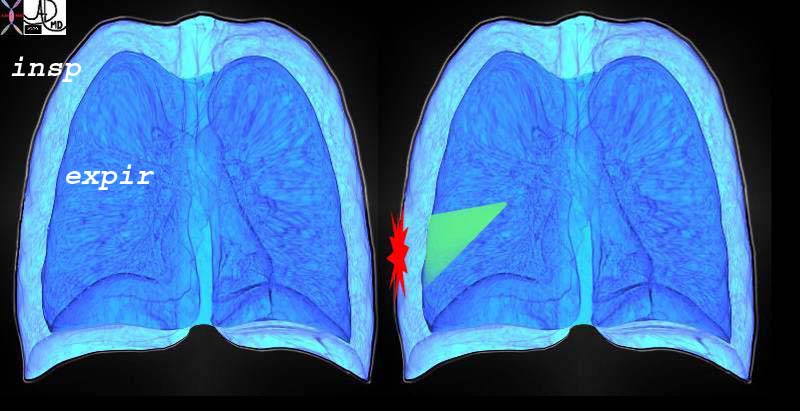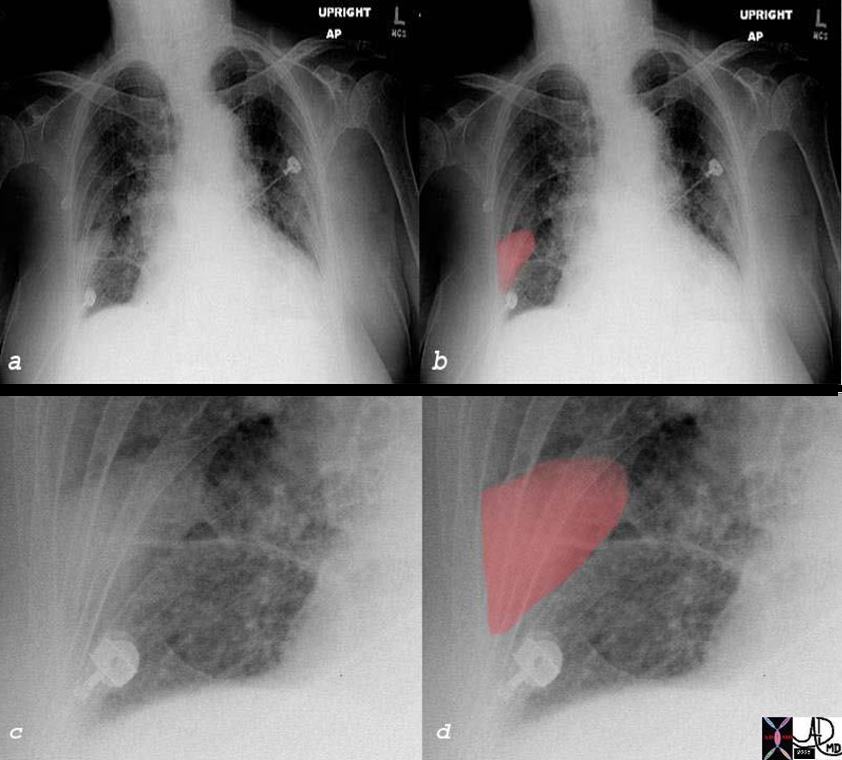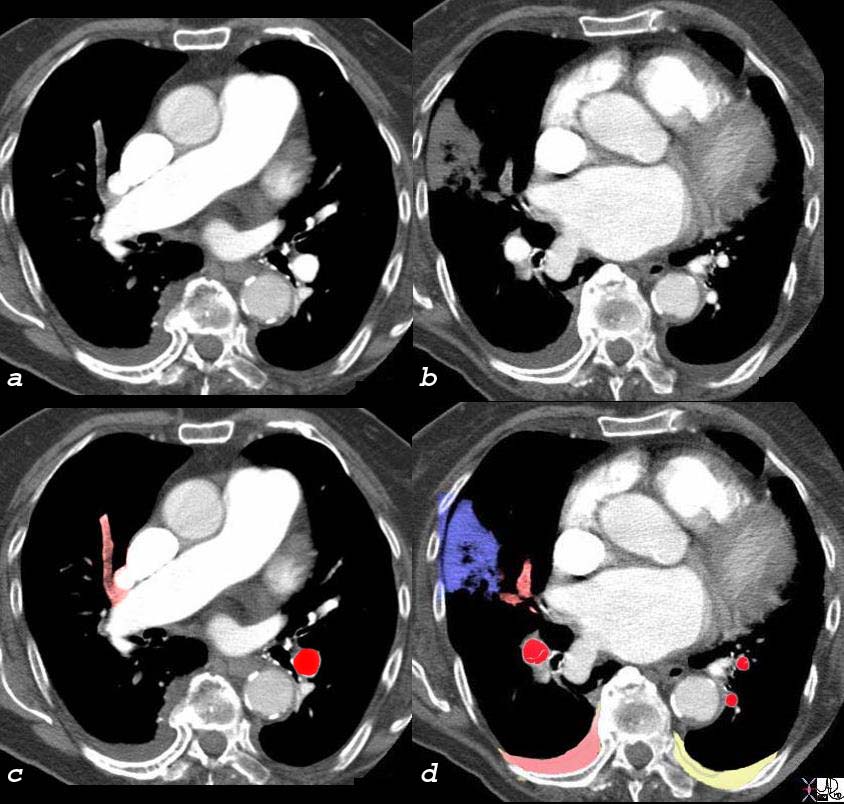Acute Thrombotic Pulmonary Embolism
The Common Vein Copyright 2008
Ashley Davidoff MD
Definition
Pulmonary thromboembolism (PE) is a circulatory disorder of the pulmonary arteries characterized by embolic occlusion of one or more pulmonary arteries by bland thrombus.
Thrombotic PE is a leading cause of morbidity and mortality particularly among hospitalized patients. Most commonly the thrombi originate from the deep venous system of the lower extremities. Less common sources include pelvic veins, upper extremity veins, right heart chambers and in situ thrombosis. The causes for the deep venous thrombosis are crystallized by Virchows triad; venostasis , endothelial injury, and hypercoaguability.
Acute thrombus in the veins is minimally adherent to the wall of the vessel and hence the propensity to embolize to the right heart and then to the lungs resulting in a variable degree of occlusion of the pulmonary circulation. In general the larger the thrmbus load the greater the clinical cosequence.
Clinically the presentation ranges from asymtomatic to sudden death. A variety of pulmonary symptoms include dyspnea, pleuritic chest pain, tachypnea, cough, anxiety, while clinical examination may reveal non specific rales, tachycardia, or low grade fever.
The diagnosis is based on high clinical suspicion by the “clot concious” care giver, usually in the presence of lowered oxygen saturations and increase in the alveolar-arterial gradient . Visualization of thrombus in the pulmonary circulation using CT angiography is the gold standard however.
Treatment is usually by anticoagulation and in a selected few where the thrombus load is life threatening thrombolysis or thrombectomy are considered.
Normal veins Courtesy Ashley Davidoff MD. 26032d
Pulmonary embolism is a leading cause of morbidity and mortality and occurs in many clinical situations. It is responsible for approximately 50 000 deaths annually and has a much higher incidence, possibly as much as 500 000 per year. While there are many sources for pulmonary emboli, more than 95% occur from the deep venous system of the lower extremities. Risk factors for include immobilization, surgery, trauma, congestive heart failure, oral contraceptives, malignancy and pregnancy. Emboli cause increased pulmonary artery pressure and ischemia of the affected pulmonary parenchyma. Occlusion of a major pulmonary artery can lead to sudden increase in pulmonary artery pressure, diminished cardiac output, right sided heart failure and death. Clinical outcomes range from resolution (60-80%), pulmonary hemorrhage or infarct (20%), shock (5%), pulmonary hypertension (2-3%) and death (5-10%). Clinical manifestations include sudden onset of dyspnea, pleuritic chest pain and hemoptysis. Physical exam findings include tachycardia or signs of right heart failure in cases of massive PE. Findings of DVT is an excellent indicator of PE.
Venous thromboembolism is any thromboembolic event occurring within the venous system, including deep vein thrombosis and pulmonary embolism. Deep vein thrombosis is a radiologically confirmed partial or total thrombotic occlusion of the deep venous system of the legs sufficient to produce symptoms of pain or swelling. Proximal deep vein thrombosis affects the veins above the knee popliteal, superficial femoral, common femoral, and iliac veins). Isolated calf vein thrombosis is confined to the deep veins of the calf and does not affect the veins above the knee. Pulmonary embolism is radiologically confirmed partial or total thromboembolic occlusion of pulmonary arteries, sufficient to cause symptoms of breathlessness, chest pain, or both. Postthrombotic
syndrome is oedema, ulceration, and impaired viability of the subcutaneous tissues of the leg occurring after deep vein thrombosis. Recurrence refers to symptomatic deterioration owing
to a further (radiologically confirmed) thrombosis, after a previously confirmed thromboembolic event, where there had been an initial partial or total symptomatic improvement. Extension refers to a radiologically confirmed new, constant, symptomatic intraluminal filling defect extending from an existing thrombosis.
Principles
Although we have understood the basic pathophysiology of a pulmonary embolus for many years, the morbidity and mortality associated with this disease remains unacceptably high.
It is estimated that upto 500,000 suffer from pulmonary emboli each year and that upto 50,000 of those will die.
Veins of the thigh show a tram track sin with extensive deep vein thrombosis (DVT) Courtesy Ashley Davidoff MD. 26061
Unfortunately, many of the embolic events are instantly fatal and it is often difficult to make the diagnosis of pulmonary embolus in those who survive the initial event. The clinical presentation of these patients is usually non-specific and the meaning of our diagnostic tests is frequently misunderstood.
PE with DVT of vein LPA Courtesy Jeffrey Pierce and Ashley Davidoff MD 32301
Historical Aspects
In the 1800s Virchow described the classic triad of causative factors for venous thrombosis, including a state of hypercoagulability.
 |
Rudolf Virchow and his wife Rose (1851) This image may be copyrighted Archives of the University of Wurzburg 54467 code historical
Theodore Roosevelt 26th President of the United States, 1901-1909. Lived 1858-1919.
Roosevelt had had a pulmonary embolus three weeks prior to death.
Death was ascribed to a pulmonary embolus. Before he went to bed, on the night of his death, there was an episode of breathlessness . A servant noticed at 4 a.m. that Roosevelt’s breathing was irregular, and “went at once to the bedside.”
1963 Henry Wagner first used radiolabeled albumin aggregates for imaging lung perfusion in normal persons and patients with pulmonary embolism.
Until the 1990s, there were not many diseases that were known to predispose to hypercoaguability
In the early 1990’s the landmark Prospective Investigation of Pulmonary Embolism Diagnosis (PIOPED) study was published, indicating guidelines for interpretation of ventilation-perfusion studies.
MDCT introduced in the early years of the new millenium is now the method of choice for pulmonary embolism.
Standard inpatient treatment of deep venous thrombosis with 5 to 7 days of Now that there is more frequent use of low-molecular-weight heparin since the late 1990’s outpatient treatment of this entity is becoming standard.
Thrombolysis percutaneous embolectomy,IVC filter – only last order?
Classification

| Occlussive Embolic Disease with Pulmonary Infarct
Wedge Shaped Peripheral and Pleural Based |
| This is a post mortem specimen of a lung in a patient who had primary lung carcinoma with metastatic liver disease, portal vein thrombosis, a small pulmonary embolus (3) and a hemorrhagic pulmonary infarct in the LUL. Note the intimate relationship of the infarct to the pleural surface.
Courtesy Ashley Davidoff MD. 32190c code lungs pulmonary artery thrombosis embolus PE infarction hemorrhage hemorrhagic wedge shaped grosspathology a87-462 Hamptons hump |

This is an example of a relatively small saddle embolus that is straddling the pulmonary arterial bifurcation. Courtesy Ashley Davidoff MD.
Fat Embolism
Tumor Embolism
Septic Embolism
Amniotic Fluid Embolism
Chronic Thrombotic Large Vessel Pulmonary Artery Obstruction
Chronic Small Vessel Pulmonary Thrombosis
Pulmonary Thromboembolism
Statistics
Pulmonary embolism is a leading cause of morbidity and mortality and occurs in many clinical situations. It is responsible for approximately 50 000 deaths annually and has a much higher incidence, possibly as much as 500 000 per year.
A prospective Scandinavian study found an annual incidence of 1.6–1.8/1000 people
in the general population. One postmortem study estimated that 600 000 people develop pulmonary embolism each year in the USA, of whom 60 000 die as a result.
Genetic Factors
There are a number of genetic aberrations that result in a hyprercoaguable state
factor V Leiden mutation is the most common inherited cause of hypercoaguability
Others include
hyperhomocysteinemia
Prothrombin G-A20210 gene variant – protein C deficiency
protein S deficiency
antithrombin III deficiency
Predisposing Factors
Risk factors for deep vein thrombosis include immobility, surgery (particularly orthopaedic), malignancy, smoking, pregnancy, older age, and inherited or acquired prothrombotic clotting disorder. The oral contraceptive pill is associated with increased risk of death due to venous thromboembolism (ARI with any combined oral contraception: 1–3/million women a year). The principal cause of pulmonary embolism is a deep vein thrombosis. Risk factors for PE are related to deep venous thrombosis as lower extremity DVT are the source of over 95%.
Pulmonary embolus is also associated with:
Stroke
Heart Disease
Peripheral Vascular disease
Deep Vein thrombosis
Diabetes
Fractures – (mainly lower extremity)
Malignancy
Immobilization (prolonged bed rest, long airplane flights)
Malignancy
Surgery
Severe trauma (multiple fractures or burns)
Congestive heart failure
Oral contraceptives
Pregnancy
Stasis: DVT, Immobilization ( formed 2ry to cast, long-distance airplane travel, taxi/bus driver, etc.), Polycythemia, SC, Burns, Pregnancy, Obesity,
Cardiac: Arrhythmia, CHF, Cardiomyopathy, Indwelling Central Line.
Hypercoagulability: BCP (estrogen based), Malignancy, homocystine, protein C or S
Trauma: Postoperative state, Leg trauma,
Prior PE or DVT, protein C or S, LES (antiphospholipid).
Fat embolism (liposuction or bone fracture).
This elderly woman presented with acute respiratory difficulty with swelling of her left upper limb. CT shows extensive pulmonary embolic disease to the lower lobes from second order branches to the tertiary branches (1-4 with green overlay) and evidence of thrombosis of the left subclavian vein. (5,6). Swelling over the anterior chest including the pectoralis muscles is evident in 7. Courtesy Priscilla Slanetz MD. 32538cLW
Pathogenesis
Since over 95% of all PE arise from thrombi within the large deep veins of the lower legs, the discussion of the pathogenesis will focus on thrombogenesis.
The factors that predispose to thrombosis are endothelial injury, stasis or turbulence of blood flow and hypercoagulability.
Stasis plays the dominant role in thrombogenesis in the venous side of the circulatory system because of low flow velocity. This is in contradistinction to the arterial side where endothelial injury is likely the dominant factor. Most often, venous side thrombosis starts behind the valve cusps in the deep venous system of the lower extremities.
Hypercoagulability is an alteration in the clotting mechanism predisposing to thrombosis.
Endothelial injury is an important factor in thrombogenesis. Potential causes include hypertension, bacterial toxins or endotoxins, toxins from cigarette smoking, homocystinuria and hypercholesterolemia. Endothelial damage exposes the subendothelial collagen which acts as a focus of platelet aggregation.
Natural History
The clinical outcomes of pulmonary embolism are resolution (60-80%), pulmonary hemorrhage or infarct (20%), shock (5%), pulmonary hypertension (2-3%) and death (5-10%).
Most PE are small and therefore silent
The annual recurrence rate of symptomatic calf vein thrombosis in people without recent surgery is over 25%. Proximal extension develops in 40–50% of people with symptomatic calf vein thrombosis.
Proximal deep vein thrombosis may cause fatal or non-fatal pulmonary embolism, recurrent venous thrombosis, and the postthrombotic syndrome. One case series (462 people) published in 1946 found 5.8% mortality from pulmonary emboli in people in a maternity hospital with untreated deep vein thrombosis. One non-systematic review of observational studies found that, in people after recent surgery who have an asymptomatic deep calf vein thrombosis, the rate of fatal pulmonary embolism was 13–15%.10 The incidence of other complications without treatment is not known. The risk of recurrent venous thrombosis and complications is increased by thrombotic risk factors.
Grosspathology
The gross pathologic findings of pulmonary embolism depends on the size of the embolus.
Large emboli that occlude the main pulmonary artery or its main branches can cause sudden death from hypoxia or acute right sided heart failure (acute cor pulmonale) that no changes in the lungs is seen.
Smaller emboli can become lodged in medium or small sized pulmonary arteries. When this occurs, ischemia of the affected lung parenchyma, if mild, can cause alveloar collapse and atelectasis from decreased surfactant production. If the ischemia is more severe, damage to the endothelial cells of affected alveoli results in pulmonary hemorrhage. If the there is compromised cardiac output, pulmonary infarction can occur. Pulmonary infarcts are commonly multiple and peripheral, typically occuring in the lower lobes. Pulmonary infarcts are wedge or triangular shaped with the base abutting the pleural and the point directed centrally.
 |
This is a post mortem specimen of a lung in a patient who had primary lung carcinoma with metastatic liver disease, portal vein thrombosis, a small pulmonary embolus (3) and a pulmonary infarct in the LUL. Courtesy Ashley Davidoff MD. 32190c code lungs pulmonary artery thrombosis embolus PE infarction hemorrhage hemorrhagic wedge shaped grosspathology a87-462 Hamptons hump
 |
This postmortem specimen is of a coalminer who developed an opacity in the right apex. (1,2) At autopsy a wedge shaped infarct was present (3,4,5,6 overlayed in red 4 and 6) with thrombus in the apical segmental artery(5,- overlayed in red in 6) Histology shows thrombus occupying the vessel (7, and overlay in red 8) Courtesy Ashley Davidoff MD. 32328c3
Clinical Presentation
The pain of pulmonary embolism is also fairly dramatic but is most commonly pleuritic in nature meaning it is somatic, sharp, aggravated by deep inspiration and coughing and relieved somewhat at expiration. It results from pleural involvement from a distal pulmonary infarction. However, patients with massive pulmonary emboli involving the larger and central vessels can present with substernal chest pain as a result of vessel distension. Patients with massive pulmonary emboli may also present with respiratory distress, hypotension and failure of the right ventricle secondary to a sudden increase in the right ventricle’s afterload. The impending sense of doom originally described as “angor animi” (anguish of the soul as described above) may accompany the pain of pulmonary embolus particularly if the pulmonary embolus is large and or there is a massive outpouring of catecholamines.

| Pleuritic Chest Pain |
| The pleuritic pain demonstrated on the right side of this patient is characterized by focal intense (bright red) and sharp pain that is aggravated by deep breaths and by coughing. The location corresponds to the disease and to the images described below.
71197b03p chest lung pleura pleuritic pain PE pulmonary Embolus pneumonia pleurisy aggrrvated by deep inspiration coughing rib fracture pleuritic pain pleurisy CTscan 3D Courtesy Ashley Davidoff MD |

| Sharp Intense Pleuritic Pain on Inspiration Due to Pulmonary Embolus and Pulmonary Infarction |
| This diagram re-enforces the concept of the pleuritic pain being related to respiratory movements and is focal and overlying the disease process. The outer part of the diagram represents the expanded lung of inspiration and the inner less voluminous lung represents the deflated lung of expiration. The green wedge represents the infarcted are of lung from the pulmonary embolus that abuts and involves the visceral and parietal pleura.
42540c02d lung inspiration expiration pain on inspiration focal severe pain pleuritic pain PE pulmonary embolus Davidoff art Courtesy Ashley Davidoff MD |
- a) very inaccurate (about50%)
b) frequent historical findings:
pain
swelling
erythema
frequent physical findings:
Homan’s sign (in 20% patients with DVT & 30% without DVT)
palpable cord (in 30% patients with DVT & 30% of patients without DVT)
The patient may present in many ways.
Dyspnea, Pleuritic Chest pain, (may be present 3-4 days prior to diagnosis)
Tachypnea
Cough
Anxiety
Rales (50%)
Tachycardia (40 – 50%)
Low grade fever (40%)
DVT in about 30% of cases
Other presetations:
Sudden onset
One or multiple symptoms
Cough — may be blood-tinged
Shortness of breath
Chest pain may be worse with breathing or coughing
Pain may be on one side and may worsen with bending forward.
Anxiety and restlessness
Person may faint (syncope)
Sweating
Wheezing
Rapid shallow breaths
Cyanosis
Hypoxia
Rapid, pounding, or Racing Heart rate
Edema in the legs
Pain in the back of the legs
Joint pain
Dizziness
Pain in the pelvic areas
Sometimes no symptoms appear
Sudden death may occur
Lab Tests
As a result of pulmonary embolism, blood gases may be altered.
A-a gradient = [(713) x (FiO2)] – [PaCO2 x 1.25] – PaO2.
Normal is 10 to 15 mmHg. The A-a gradient must be adjusted to age if pt is > 65 years. After the age of 60-65, PaO2 drops by about 1mmHg for every year.
Fibrin degradation products- Positive D-dimers 30-40% specific. Negative D-dimers are 90% sensitive in excluding PE and posite DVT/PE were witnessed in presence of negative D-dimers. Both depend on the methods (ELISA vs. latex, whole blood vs. plasma) used by hospital lab.
Positive D-dimers 30-40% specific. Negative D-dimers are 90% sensitive in excluding PE and posite DVT/PE were witnessed in presence of negative D-dimers. Both depend on the methods (ELISA vs. latex, whole blood vs. plasma) used by hospital lab.
Check for protein C+ S deficiency
Imaging
V/Q scan. High probability V/Q is essentially diagnostic, and medium probability V/Q is diagnostic if there are other S & S that could create a high clinical suspicion of PE (O2 SAT <95%, DVT, SOB, >A-a gradient, Tachycardia, Tachypnea). If medium probability V/Q is not accompanied by S&S but pt has risk factors, Pulmonary Angio is the next step for dx. Patients with low probability V/Q have 10% chance of having PE, and patients with normal V/Q still have as much as a 5% chance of having PE. Risk factors, S & S and proper F/U must be taken into account in these categories of patients.
Spiral CT. This rules out only life threatening large PE but cannot r/o PE to small vascular bed. Negative CT should be regarded similarly to a “low” probability V/Q and pt should be treated on the basis of clinical exam and clinical suspicion.
ECHO. Patients unstable to leave the monitored bed would benefit from bedside ECHO. Clear signs of R ventricular failure may suffice for the dx of PE in proper setting, i.e. in pt with clinical evidence of PE. In addition it also helps to r/o other entities causing hypotension such as MI, Aortic Dissection, Tamponade.

Wedge Shaped Defect on CXR Hamptons Hump – Pleural Based Infarction |
| The plain film of a patient with right sided pleuritic pain and hypoxemia is shown. Image a shows a vague wedged shaped defect in the right lower lobe (overlaid in red in b), enlarged in c and d. This wedge shaped peripheral based defect is known as Hampton’s hump, and is suggestive of a pulmonary infarction, and subsequently proven as seen on the images below. When a pulmonary embolus causes an infarction, it may be seen as a wedged shaped defect on the CXR. Since the pulmonary circulation of the lung is an end arterial circulation, the most distal portion of the segment of the lung and its pleura will be affected. The accompanying inflammatory process will involve the pleura and pleuritic pain ensues.
39693c01b chest lung lower lobe peripheral wedge shaped defect infiltrate Hampton’s hump PE pulmonary embolus infarction heart cardiac enlarged failure chf circulatory vascular CXR chest X-ray plain film imaging radiology Courtesy Ashley Davidoff MD |

| Occlussive Embolic Disease with Pulmonary Infarct |
| The CTscan of this patient shows an occlussive embolus (gray in a overlaid in pale red in c) as well as the branches of this vessel (gray in b and overlaid in pale red in d) resulting in a peripheral pleural based infarction (gray in b and overlaid in blue in d). There are bilateral effusions with right effusion (pink overlay) likely to be hemorrhagic and the left effusion likely to be transudative. Pulmonary infarction as seen in this case is not common since the lung receives oxygen directly from the alveoli, as well as from the bronchial arterial circulation. However in this patient, there was associated congestive heart failure and perfusion and ventilation were rduced at base line. When one adds insult to injury with a PE, compensatory mechanisms are not available and infarction ensues.
39693c05b chest lung lower lobe peripheral wedge shaped defect infiltrate Hampton’s hump PE pulmonary embolus infarction heart cardiac enlarged failure chf bilateral pleural effusions hemorrhagic pleural effusion inferred circulatory LAE left atrial enlargement vascular CTscan imaging radiology Courtesy Ashley Davidoff MD |
Treatment
O2
Heparin dose is 5000 – 10,000 U bolus followed by 25,000 U in 250 D5W @ 10 – 15cc/hr (or 17U / kg / hr). Peak effect in 20-60 min and T1/2 0.5-2.5 hr.
Enoxaparin (Lovenox) is used more frequently nowadays. Administered SQ. No PT, PTT monitoring is needed. Peak effect occurs after 3-5 hrs. Is eliminated renally, and RF prolongs T1/2, yet dose adjustment is not needed. Usual T1/2 is 12 hrs. Can be given in pregnancy. If reversal is needed Protamine is given; and 1 mg Protamine reverses 1 mg of Enaxaparin. The dose for treatment of acute PE is 1.5 mg/kg qd or 1 mg/kg SQ bid x at least 5 days, with warfarin started on day 2 (while Lovenox is continued until PT is therapeutic for 5 consecutive days).

Pretretment and 2 weeks Post Treatment |
| 78540c02s elderly lady wih breast carcinoma presents with SOB lung artery filling defects pulmonary emboli 2 weeks following treatment emboli resolved Courtesy Ashley Davidoff MD copyright 2008 |
Thrombolytics used only when documented PE causes hemodynamic compromise.
Embolectomy.
Venous Doppler. When positive in the presence of pulmonary S & S and the presence of “low -to-medium probability” V/Q, Heparin treatment for PE is indicated.
Angiogram. Indicated when:
V/Q is low-mod probability and DVT study is negative, yet pt has high clinical suspicion based on S&S and/or risk factors.
Patient is High risk for bleed if put empirically on anticoagulants.
Web References
References
